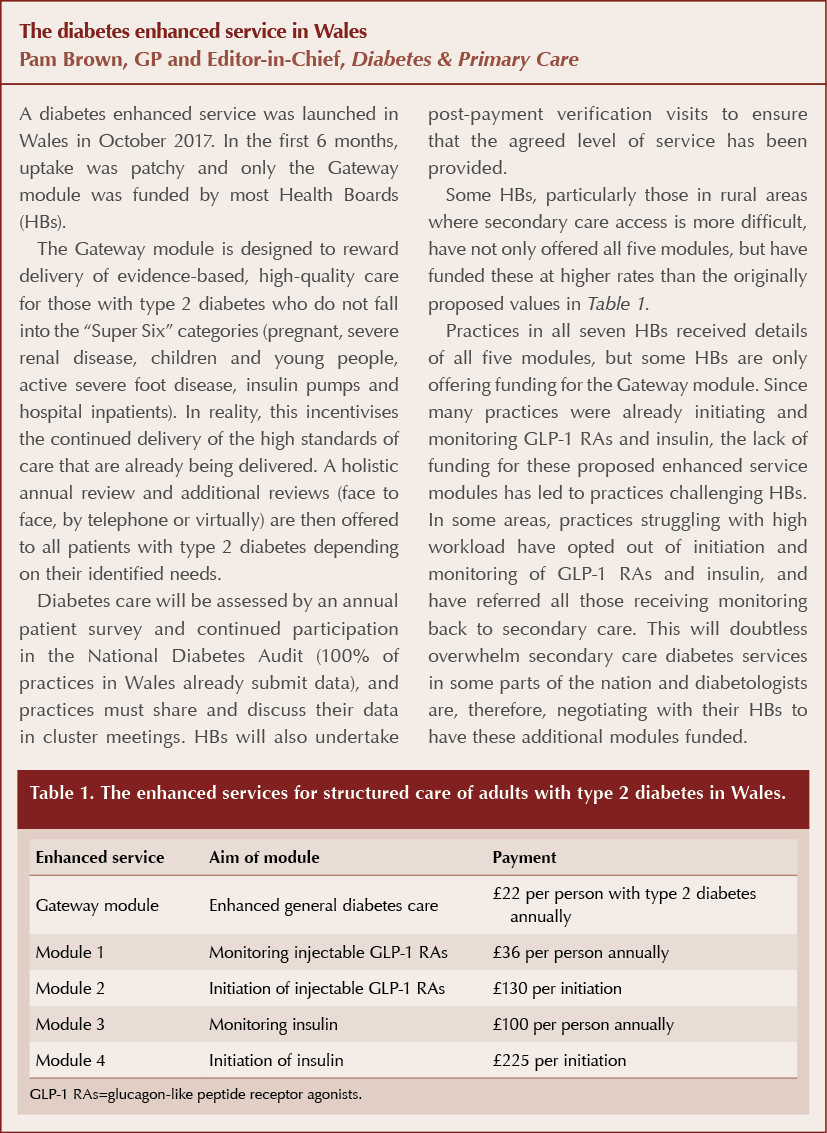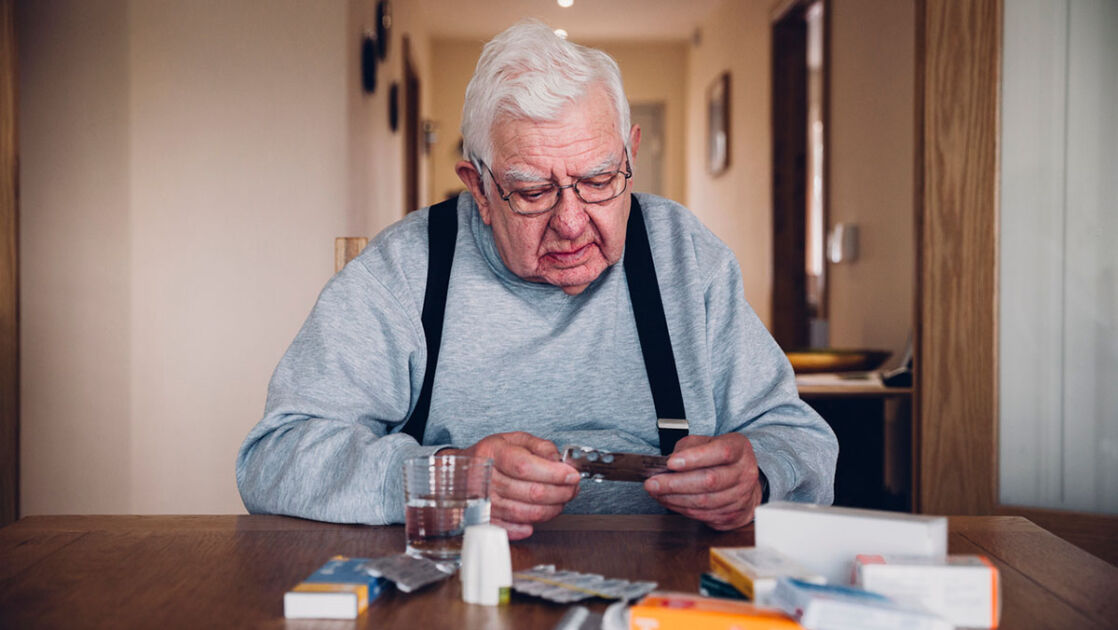GP services in England are contracted to provide core (essential) and additional services to their patients. Where the provision of primary medical services have been agreed on top of these services, they are called Enhanced Services. They may be used to fill in a gap in core services or to deliver core services to a higher than specified standard. As such, they provide opportunities to improve clinical and process outcomes in local health services. There are three types of Enhanced Service, depending on how the service is commissioned and what it is commissioned for: directed enhanced services, LESs and local improvement schemes. This article focuses on the local enhanced service and its effectiveness in addressing locally identified needs.
In the process of developing a LES for diabetes for Oxfordshire Clinical Commissioning Group (CCG), a lack of information about what constitutes an effective local enhanced service for diabetes was identified. In particular, what intervention is taken up quickly by GP practices and what makes a successful LES. Our analysis adds to the literature that identifies a need for understanding the processes by which financial incentives influence care (Jackson et al, 2017; Mandavia et al, 2017). A search for evidence highlighted the lack of good quality information available on the characteristics and outcomes of concluded LESs for diabetes, perhaps because LESs are local initiatives, responding to a local need. However, since a LES boosts core services, there are likely to be similarities in local needs across the NHS. Knowing what interventions are successful would be invaluable for others to build on when distributing limited resources.
What is a local enhanced service?
Before 2012, there were three types of enhanced services. When the Health and Social Care Act 2012 came into force in 2013, the arrangements became:
1. Directed enhanced services (DES). Nationally commissioned through GP contracts by NHS England, with national specifications and benchmarked pricing.
2. Local enhanced services:
a. Community-based services. Locally commissioned to reflect needs and priorities.
b. Transitional local enhanced services. Responsibility for LESs that had not expired on or before 31 March 2013 was transferred to NHS England, which delegated the management of these services and associated funds to CCGs. CCGs can review these LESs and decide if they wish to invest these funds in the current services or in alternative community-based services.
3. Local improvement schemes. Resources used from the CCG budget to pay for improvements in services provided under the GP contract or to support activities such as clinical audit or peer review. CCGs do not have powers in their own right to pay for improvements in services provided under the GP contract and can apply to the relevant NHS England area team for delegated powers to use their budget (NHS Commissioning Board, 2012; British Medical Association, 2016).
Across the UK and for a number of health conditions, LESs have been used for a variety of purposes, including (adapted from Kumar et al, 2014):
- Improving access to specialist care.
- Improving identification of patients with undiagnosed disease.
- Improving patients’ engagement with healthcare and adherence to treatment.
- Increasing primary care capability.
- Improving disease management.
- Improving care in care homes.
The use of a local enhanced service in diabetes commissioning
An overview of the content of a LES for diabetes
The review of LESs for diabetes was complicated as there is no national database with reports of concluded LESs. The only way to collect this information is to contact every commissioner. This was done in 2010 when 147 Primary Care Trusts (PCTs) in England were approached, with 63 responding, 26 of which confirmed using LES (Gadsby and Khunti, 2013). Three types of services were reported as commissioned: insulin initiation and follow-up, oral glucose tolerance testing in practice and glucagon-like peptide-1 initiation in practice. In the first, payments ranged from £80–£200 per patient for insulin initiation, with an additional £120–£162 for follow up per year (with an average of three follow-ups). This indicated existing variations in interventions and incentives, but it did not confirm which interventions were more effective.
We investigated the public availability of diabetes LES intervention specifications and their evaluations. The Contract Finder online tool (http://bit.ly/2M2Airs) requires commissioners to advertise contracts above £10000, but the level of detail of planned interventions and evaluation vary and, being focused on the procurement opportunities, it does not provide the evaluation itself. The NICE Evidence Search has an option of searching practice-based information, but only one diabetes LES case study was available. Most of the results of an Internet search for “local enhanced service” and “diabetes” were planned services, with few reporting on concluded LESs and their outcomes. To gain an overview of diabetes LESs and their outcomes, 11 documents that were listed in an Internet search covering LESs from the UK in the last ten years were convenience sampled. This revealed a variety of purposes for LESs in diabetes care and services including:
- Insulin initiation and follow-up (with payments ranging from £110 to £305 per patient for initiation and follow-up per year).
- Care planning with diabetes annual review.
- Longer appointments to complete eight care processes.
- Dedicated protected diabetes clinic time, with one session to undertake the annual diabetes needs assessment and development of the agreed diabetes care and management plan.
- Review of all patients managed by secondary care and discharge of patients not meeting the referral criteria.
- Review of complex or sub-optimally treated diabetes patients.
- Review of national and local developments by participating in local forums.
- Participation in the National Diabetes Audit.
LESs for diabetes have been commissioned to address three themes: 1) to provide comprehensive community diabetes management for patients who would benefit from it (with the appropriate support from the specialist services); 2) to prevent diabetes complications; and 3) to support self-management. We were interested to find out if, and how, a LES has been used to promote integrated care (i.e. person-centred, coordinated care). Such a LES could shift care to primary care to encourage its continuity and provision close to home. This could include upskilling primary care healthcare professionals to make them more confident in treating individuals who would otherwise be referred to a specialist service. To make care more person-focused, a LES would help to protect primary care time and provide primary care clinicians with tools to improve engagement with patients to help better address their needs.
Evaluation of existing LESs for diabetes
In assessing the success of a LES, two key factors are taken into consideration: participation rates and the impact on health and financial outcomes.
Of 11 diabetes LESs we reviewed, eight indicated a completed or planned evaluation and described it to a limited extent. The remaining three included no evaluation strategy. Three CCGs could report the impact that the LES made, but neither the participation rates nor the financial impact were systematically reported. All three LES programmes made a positive impact in some or all areas of concern.
- In Birmingham East and North PCT, all patients from secondary care who did not meet criteria for referral were discharged to the LES participating practices (76 LES practices against 34 non-LES practices; Choudhury, 2013). Diabetes clinics at these practices were funded to take place at least twice a year, with one session being an annual diabetes needs assessment and development of the agreed diabetes care and management plan. The LES practices were more likely to achieve glycaemic outcomes and less likely to refer to secondary care but there was no difference for blood pressure and lipids.
- In West and South Yorkshire and Bassetlaw (2013), LES practices managed patients with diabetes on insulin/GLP-1 receptor agonist therapy. They were evaluated with regard to meeting patients’ needs, maintaining clinical care close to home and being significantly more cost effective than running a similar service in secondary care.
- In Greater Glasgow & Clyde (2010), the practice nurses in LES practices were responsible for an annual interview to screen for problems and support onward referral to appropriate services that can provide ongoing support for individuals. Evidence of considerable progress in achieving more even distribution of intermediate clinical outcomes (cholesterol and BMI) was observed.
These are promising results and commissioners considering improvements to diabetes care in other areas would benefit from knowing what has worked elsewhere. However, a simple adaptation of interventions that have been effective and efficient somewhere else may not guarantee success.
In terms of primary care participation in LESs, it is important to understand the conditions that encourage practices to take on additional work. There are some general lessons to be shared from the literature on LESs: aligning a LES with an existing national framework may have positive spillover effects and increase LES activity; ensuring that the existing conditions of service provision support the requested activities may have an impact; and the size of the financial incentives may affect participation (Kumar et al, 2014).
Our review revealed other practices used by commissioners to encourage participation. Some recognised the importance of introducing eligibility criteria for participation in a LES (West and South Yorkshire and Bassetlaw Commissioning Support Unit, 2013). Another tactic was conducting a transparent evaluation, referring to the LESs conducted in previous years and building a narrative of continuous improvement (NHS Greater Glasgow & Clyde, 2010).
A LES can play an important role as a short-term catalyst for the development of a solution for a higher standard of care and better health outcomes (Kumar et al, 2014). However, there is no readily accessible information on what happens to practice when a LES is withdrawn or terminated, and whether the solutions having a positive impact are stopped by the providers or continue to be supported with the providers’ resources. This lack of evidence on the long-term impact of LESs can result in the halting of the previous LESs and a focus on spending any available financial resources on doing something new. As tempting as this may be, long-term thinking is needed to keep engagement with service providers and provide a learning environment for continuous improvement. The questions to ask are:
- Does the existing LES need replacing or rather improving/adjusting?
- If it didn’t work, why?
- Is the LES-supported activity still in place and effective after funding was withdrawn?
- Could LESs be undertaken with fewer resources so more programmes are commissioned?
Conclusion
Significant resources have been spent in recent years on schemes aimed at improving diabetes care. A review of one such scheme, a LES for diabetes, revealed only a small number of reports with details of the interventions implemented and their evaluation. There may be several reasons for this. Commissioners designing and evaluating LESs locally, may not recognise the potential of mutual learning. Some LESs may lack evaluation altogether, as they are commissioned to fill short-term gaps, with no feedback or follow-up on the service provided. There is a missed opportunity to understand the effectiveness of this specific (locally motivated, voluntary and incentivised) commissioning tool.
To understand what impacts on the success of a LES, it is important to collect good data and use this internally and externally to learn lessons. Including requirements for data reporting and feedback in the LES specifications may motivate service providers to participate in evaluation. Putting outcomes systematically in the public domain may help to build evidence that can be evaluated with best practice for an identified LES. For this to happen, a more systematic approach to data collection is needed, with description of:
- The context of intervention – why was it introduced?
- How the decision about the intervention was made – who initiated it and who was consulted?
- The interventions.
- The eligibility criteria.
- The participation rate and reasons for non-uptake.
- The incentive, including what was being incentivised (activities and/or successful outcome) and when the incentive was rewarded (an initial start-up payment and/or a closing fee).
- Outcomes.
- Evaluation process.
Having a single online point for depositing and accessing commissioned and evaluated LESs for diabetes would help to improve the practice of engaging in voluntary healthcare schemes and incentivising better outcomes. NICE offers a platform with local practice case studies. Commissioners who wish to share their experience of NICE guidance and standards being used to change and improve local services can submit their examples to NICE for approval. Once quality assured, the case studies are published on the NICE website for others to learn from and adopt. Case studies can be submitted using the online submission form at http://bit.ly/2M9oL9P.






Primary care has the potential to prevent up to 45% of the population attributable risk of dementia.
17 Sep 2024